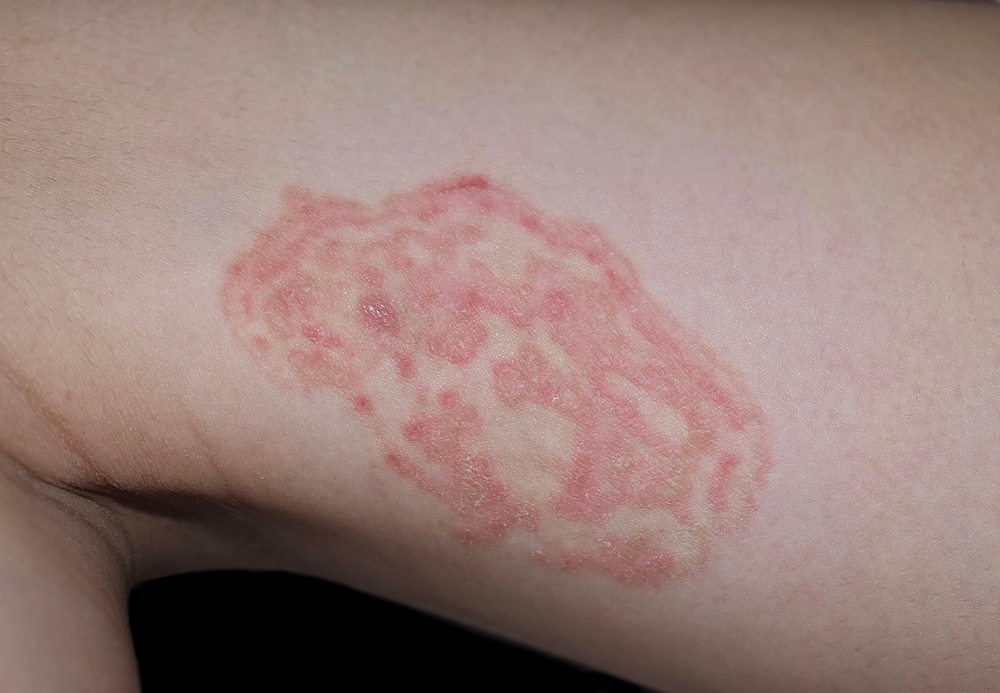Tinea Corporis: Causes, Symptoms, and Treatment of the Fungal Skin Infection
Tinea corporis, also known as ringworm , is a fungal skin infection characterized by circular, ring-shaped rashes. It can appear on various areas of the body, except the scalp, groin, palms of the hands, and soles of the feet. Although highly contagious, it generally does not pose a serious health risk.

What is Tinea Corporis and How is it Classified?
Tinea corporis is part of a group of fungal skin infections, each with a specific name depending on the affected area:
- Tinea pedis: Known as athlete’s foot.
- Tinea cruris: Affects the groin area and is known as inguinal intertrigo.
- Tinea capitis: Infection of the scalp, common in children.
Causes: What Causes Ringworm of the Body?
This infection is caused by a group of fungi called dermatophytes , which feed on keratin, a protein found in the skin, hair, and nails. These fungi thrive in warm, moist environments , which makes them easy to spread through:
- Direct contact with an infected person.
- Indirect contact through contaminated objects (towels, clothing, shower and changing room surfaces).
- Infected pets , such as cats and dogs.
- Humid environments , such as gyms, swimming pools and saunas.
Risk Factors
Anyone can get tinea corporis, but certain factors increase the risk of infection:
- Warm and humid climates .
- Wearing tight-fitting clothing that retains moisture .
- Frequent contact with animals .
- Sharing personal items such as combs, towels or clothing .
- Diseases that weaken the immune system , such as diabetes.
Symptoms of Tinea Corporis
Symptoms usually appear 4 to 10 days after contact with the fungus. Common signs include:
Initial Symptoms
- Circular, reddish rashes with a clear center.
- Intense itching in the affected area.
- Peeling or cracked skin around the lesion.
- Burning sensation or mild irritation .
Symptoms in Severe Cases
If the infection is not treated in time, it can worsen:
- Expansion and fusion of the rings in the skin.
- Appearance of blisters with pus .
- Intense swelling and redness.
- Temporary hair loss if it affects hairy areas.
Diagnosis of Tinea Corporis
A dermatologist can diagnose tinea corporis by:
- Visual examination: Observation of the shape and pattern of the lesions.
- Skin scraping: Taking a sample for microscopic analysis.
- Fungal culture: In some cases, the sample is sent to a laboratory to confirm the responsible fungus.
It is important to differentiate ringworm from other conditions such as eczema or psoriasis to receive the appropriate treatment.
Treatment for Ringworm of the Body
Tinea corporis responds well to antifungal medications, which can be topical or oral , depending on the severity of the infection.
Topical Medication
For mild or moderate cases, it is recommended to apply antifungal creams or gels with:
- Clotrimazole
- Miconazole
- Terbinafine
- Ketoconazole
They should be applied 2 to 3 times a day for 2 to 4 weeks , depending on the evolution of the infection.
Oral Medication
In severe cases or those resistant to topical treatments, your doctor may prescribe oral antifungals such as:
- Griseofulvin
- Itraconazole
- Oral terbinafine
These treatments usually last between 4 and 6 weeks and require medical follow-up to avoid side effects.
Prevention: How to Avoid Infection?
To reduce the risk of infection and prevent spread:
- Maintain good personal hygiene by bathing regularly and drying thoroughly.
- Do not share towels, clothes, combs or shoes .
- Wear loose, breathable clothing .
- Wash bed linens and towels in hot water with antifungal detergent.
- Disinfect surfaces in bathrooms, locker rooms and gyms .
- Take pets to the veterinarian if they show signs of infection (hair loss, skin lesions).
When to See a Doctor
It is recommended to see a doctor if:
- Symptoms do not improve after 2 weeks of treatment.
- The rash spreads rapidly or affects sensitive areas such as the face.
- Painful blisters or pus appear .
- Fever or severe inflammation develops .
Early diagnosis and treatment not only relieve symptoms but also prevent the spread of infection to other parts of the body or to other people.


